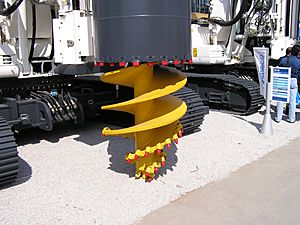Geotechnical engineering facts for kids
Geotechnical engineering is a special part of civil engineering. It's all about understanding how the ground (like soil and rock) behaves when we build things on it or in it. Imagine building a tall skyscraper or a big bridge! Geotechnical engineers make sure the ground is strong enough to hold these structures safely. They use ideas from soil mechanics and rock mechanics to figure out how the earth will act.

Geotechnical engineers do many important jobs. They study the ground to find out what it's made of and how strong it is. They also check how stable natural slopes are, like hillsides, and how safe human-made soil areas are. This helps them understand any risks the ground might have.
They also design different types of earthworks, which are projects that involve moving or shaping large amounts of soil. They design the foundations for buildings and other structures. Foundations are the parts of a building that connect it to the ground. Finally, they watch the ground conditions and how the earthwork and foundation construction are going. This makes sure everything is built correctly and safely.
Foundations for buildings can be either shallow or deep. Shallow foundations are usually wider and not very deep, like a concrete slab under a house. Deep foundations go much further into the ground, often using long piles or shafts, especially for very tall buildings or bridges. Geotechnical engineers also design structures that hold back earth, like earth-filled dams and retaining walls. These are important for preventing landslides or creating flat areas on sloped land.
Contents
What Geotechnical Engineers Do
Geotechnical engineers are like detectives for the earth. They investigate the ground before any building starts. They need to know what kind of soil or rock is there. Is it sand, clay, or hard rock? How strong is it? How much water does it hold? All these things affect how a building will stand.
Investigating the Ground
To learn about the ground, engineers take samples. They might drill deep holes to pull out cores of soil and rock. They also do tests on these samples in a lab. These tests tell them about the strength, weight, and other properties of the earth materials. They also check for groundwater, which is water found underground.
Designing Strong Foundations
Once they know about the ground, engineers design the best type of foundation for a structure. For a small house, a simple concrete slab might be enough. For a huge bridge or skyscraper, they might need deep foundations. These can be long concrete or steel piles pushed deep into the ground. The goal is to transfer the weight of the building safely to the strong layers of earth below.
Building Earthworks and Walls
Geotechnical engineers also work on projects that reshape the land. This includes designing dams that hold back water, or retaining walls that hold back soil on a slope. They make sure these structures are stable and won't collapse. They also plan how to compact soil for roads or building sites so it's firm and won't settle too much.
Why Geotechnical Engineering Matters
This field is super important for our safety. Without proper geotechnical engineering, buildings could sink, crack, or even fall over. Roads could develop dangerous potholes, and bridges might not be stable. It helps us build safe and lasting structures, even in challenging environments. For example, building in areas with soft soil or near earthquakes needs very careful geotechnical planning.
Images for kids
-
Boston's Big Dig presented geotechnical challenges in an urban environment.
-
Pile-driving for a bridge in Napa, California.
See also
 In Spanish: Geotecnia para niños
In Spanish: Geotecnia para niños








